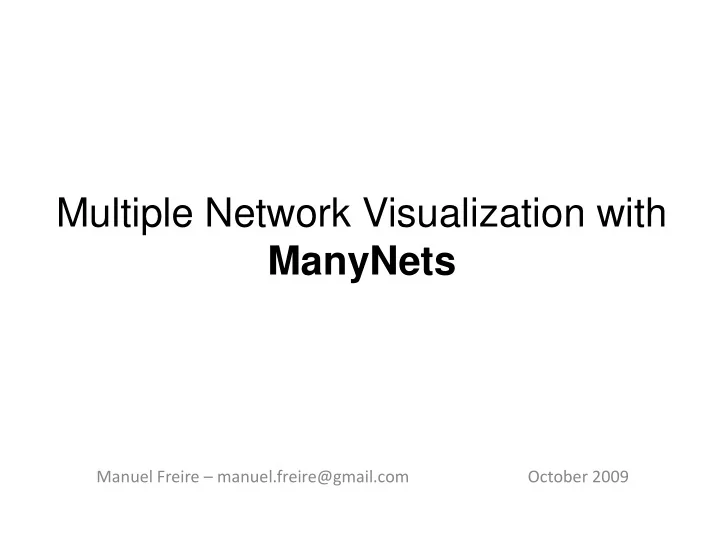

Multiple Network Visualization with ManyNets Manuel Freire – manuel.freire@gmail.com October 2009
The Cast ● Ben Shneiderman, Catherine Plaisant ● Jen Golbeck ● Awalin Sopan, Miguel Ríos ● Lockheed Martin ● Cody Dunne, John Guerra
About the author ● Madrid, Spain ● Against bull-fighting ● Not a soccer fan ● Best food in the world ● Universidad Autónoma ● Contacted Ben S. & Catherine for ● 1-year Fulbright postdoc ● But back next May :-P
Motivation for ManyNets How do you make sense of not one network, but many – up to thousands? ● What representation should we choose, when space is scarce? ● How can you “gain an overview ” of a large collection of networks? ● In which scenarios does this problem arise? When can it be useful to deal with all those networks? ● What sense-making tasks would users expect to be able to do on these networks?
Representation ● Each network is represented as a row in a table ● Network “attributes” for each network are represented in columns ● Using miniature histograms when not scalar values ● User can query cells using tooltips and clicking for details-on-demand ● Can display networks in SocialAction (see demo)
Overview ● Column summaries represent the contents of entire columns ● And highlight contributions of selected rows. ● And can, themselves, be used to highlight rows. (see demo)
Scenarios – where is this useful? ● “Compare different networks to each other” ● Facebook networks of 5 US universities ● FilmTrust vs MovieLens ● “Divide and conquer”: large networks are unwieldy ● By time : phone call network sliced into “windows” ● By neighborhood : ego-networks of FilmTrust ● By motifs : all triangles in FilmTrust, to test transitivity of trust. ● By clusters : connected components in FilmTrust.
FilmTrust vs MovieLens Five facebook groups for US universities
All ego-networks (one per person) All groups of 3 persons that all know each other (triplets) All pairs of connected people
Timesliced phone call network (VAST 2008 dataset)
Users ● Tried to train people in 15 min. for CHI usability study – fell back to “discount usability study” ● Network Analysis is not easy ● Training video not case- motivated and “hands - on” ● Multiple interface quirks ● Target uses are analysts , willing to invest time in learning the tool.
Tasks ● Find maxima, minima, general overview of the distribution of attributes. ● Zoom and filter, and provide details for any given entity. ● Work with true domain data , without shedding data to fit “network” format. ● Find “ outliers ”. ● Existence, quantity, location of user-defined, domain- relevant “ patterns .” ● Compare several networks, and show similar networks, or groups of networks.
Better overviews ● Beyond histograms: what to use to convey the overall contents of a column. ● Trends, regions, gaps, outliers min max
Details & Domain Data ● User-defined columns ● Combining different node types – the Entity- Relationship model strikes again Alice Bob age = 26 age = 24 trust = 6 User User-Film Film User-User
Outliers & Patterns ● “Visual outlier detection ” ● Pattern inspection supported via filters, user- expressions, sorting. ● Ad-hoc network pattern matching (but ask us about our ideas on how to implement it)
Similarity ● Computing pairwise similarity ● Attributes ● Graph comparison (Jaccard, edit distance) ● Displaying similarity ● As a histogram ● As a dendrogram ● As simple sort order (from sample or using TSP)
Recap How do you make sense of not one network, but many – up to thousands ? ● Representation – a table of network attributes ● Overview – column summaries, but plenty of opportunity for improvement. ● Scenarios – asides from inter-graph, intra-graph decomposition shows great promise. ● Users / Tasks – similarity, outliers, patterns are hard problems. Real data does not come as straightforward networks.
Questions? Comments? Thanks!
Recommend
More recommend